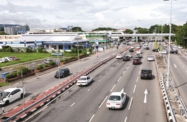An overhaul of driving regulations and the launch of a national transportation master plan are hoped to improve links in Brunei Darussalam as the country aims to play a central role in a regional trade grouping. However, convincing Bruneians to choose public transport, rather than their vehicles, appears to be a major challenge.
In February, the Centre for Strategic and Policy Studies (CSPS) held a closed-door forum with stakeholders to discuss a transport master plan study launched in late 2012. The CSPS study found that transport is the area that most concerns Bruneians, beating other social issues such as education, employment and housing. The body noted a “car dependency” in the Sultanate, which was likely due to a lack of viable transport alternatives and public transportation that respondents would prefer.
In a bid to improve public transport, the Ministry of Communication in January began assessing proposals for new taxi and bus franchise systems. Fadzila Abdul Hamid, a research and development officer at the ministry, told local media that interested companies need to meet the requirements and specifications set out by the ministry. There are five firms offering bus services in the Sultanate.
In the previous month, ministry officials said there were plans to revise ticket pricing, install CCTV cameras in buses, and publish route maps that were colour-coded to be more user friendly.
However, getting Bruneians to use public transport could prove difficult. In late 2012, the Department of Economic Planning and Development said the country has one of the highest car ownership rates in the world. In 2012 vehicle ownership was expected to surpass 160,000 and, as the Sultanate’s population currently stands at 393,372, it means there are approximately 2.65 people per vehicle. This puts Brunei Darussalam ninth in the world in terms of vehicles per capita, according to the World Bank.
Pehin Dato Suyoi Haji Osman, the minister of development, said the number of cars could exceed the number of residents if policies were not implemented to discourage excessive car ownership. The issue has led the Ministry of Development to consider a number of measures, including congestion pricing, which some neighbouring countries have adopted to reduce traffic.
In Singapore, a decades-old “Area Licensing System” imposes stiff fees for any car entering downtown Singapore during business hours. Brunei Darussalam could also emulate Singapore’s “Certificate of Entitlement” (COE) programme, which aims to limit car ownership by distributing only 30,000 certificates each year. The COE lasts a period of 10 years, at which point an owner must either deregister his vehicle or renew the certificate.
As part of broader efforts to boost the sector, the Department of Land Transport launched a road show in December 2012 to promote sweeping changes to the driver and vehicle licensing systems that will be introduced later this year. Paper licences are to be replaced with a card that utilises barcode and chip technology to reduce forgery. The card will also store a driver’s record, including demerit points, fines and road offences. Meanwhile, new vehicle registration books and an e-government system that allows drivers to apply online are to be introduced.
Such improvements and modernisation will likely prove crucial as the Sultanate gears up to play a major part in the Brunei Darussalam, Indonesia, Malaysia, Philippines-East ASEAN Growth Area (BIMP-EAGA). Indeed, Bruneian officials have confirmed that multi-modal and cross-border transport connectivity will also be addressed as part of a “holistic” approach toward improving national land transport.
At a meeting of BIMP-EAGA transport officials in September 2012, it was agreed that all members would enhance all three modes of transport connectivity – land, sea and air – within the region. “As the region has become more important, transportation activities are also becoming increasingly critical to ensure seamless flow of people and goods within the region,” Kong Cho Ha, the minister of transport, said at the event.
While improving external road and air links to facilitate investment in BIMP-EAGA is a priority for the government, the current track of first improving internal links through tighter regulation and public services seems the best route toward enhancing the transport sector.

